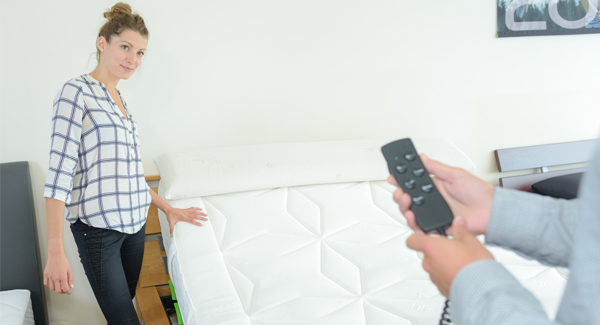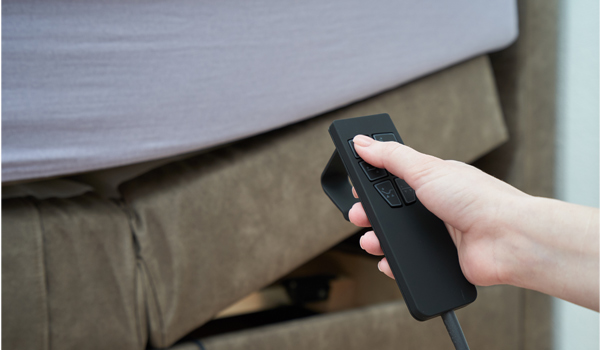Home » Mattress advice » Can You Use Any Mattress With An Adjustable Base?
Can you use any mattress with an adjustable base?
Article navigation
- Published:
- Written by: Tony Brown
- Topic: Mattress advice
Adjustable beds have become increasingly popular as they allow you to raise or lower the bed to different sleeping positions.
Adjustable beds are perfect for individuals who enjoy sitting up in bed for activities like reading, watching TV, or using a laptop. They can also relieve lower back pain, swelling, poor circulation, and arthritis. But while an adjustable bed can help with certain activities and medical conditions, choosing a comfortable and supportive mattress is essential.
Here’s what you need to know when choosing a mattress for an adjustable base.
Factors to consider when choosing an adjustable mattress
Besides comfort and support, you also need to consider additional factors, such as compatibility and flexibility when choosing a mattress for an adjustable base.
Mattress Compatibility
Adjustable bases move into various positions, so your mattress should be flexible enough so that it can easily bend and conform to the shape of the base without damaging it.
Some types of mattresses perform better on adjustable bases than others. Memory foam and latex mattresses are quite flexible and are usually compatible with adjustable bases.
Sprung mattresses are less flexible and, as most are not designed to bend, are unlikely to conform well to the bed’s movements and could be prone to damage over time. However, some pocket spring mattresses have been specifically adapted for use with adjustable bases, making them an appealing option for those who prefer a sprung mattress.
Since adjustable bases require a certain type of mattress, purchasing the mattress and base together is advisable to ensure they are compatible.
Otherwise, if you have a mattress or intend to purchase one separately, check the mattress guarantee or warranty to ensure it covers usage with an adjustable bed.
Adjustable mattress size
Ensure the size of your mattress matches the dimensions of the adjustable base. Most adjustable bases require a mattress 6’6” (200 cm) long. However, conventional single and double mattresses are usually only 6’3” (190 cm) long.
While you can purchase a 6’6” long mattress, choosing a mattress that is specifically designed for an adjustable base is advisable. This ensures the mattress is compatible and fits properly, preventing sliding issues.
Comfort and support
An adjustable mattress should feel comfortable while supporting you properly. Comfort is subjective and depends on whether you prefer sinking into a mattress or lying on top of it.
Proper support depends on various factors, such as your body weight, build, and preferred sleeping position. Generally, the heavier you are, the firmer the mattress you need. Ideally, the mattress should conform to your body while keeping your spine aligned. Opt for medium support if you’re unsure which level of firmness is best.
It’s advisable to test different adjustable mattresses in-store to determine which models you find comfortable and supportive. If you prefer to shop online, research beforehand to ensure you buy from a reputable seller. Also, consider mattresses with sleep trials or return policies that you can return to the manufacturer or seller within a specified period if unsatisfied.
Edge support
Edge support refers to the strength and stability of the mattress’s perimeter. A mattress with good edge support prevents sagging, extends the usable sleeping areas, and makes it easier to get in and out of bed.
Mattress thickness
Mattress thickness is often overlooked but is crucial for several reasons. Mattresses twelve inches or deeper may be less flexible. They may not conform well to the bed during operation and resist its movements.
A thicker mattress increases the bed height, potentially making it challenging for individuals, especially older adults or those with mobility issues, to get in and out of bed comfortably.
Additionally, finding suitable bedding for a thicker, adjustable mattress might be more challenging.
On the other hand, whilst a thinner mattress might be more flexible, it may lack adequate comfort and support.
Traction
Generally, adjustable bed mattresses are designed to minimise sliding or shifting when the bed’s position is adjusted. Most adjustable beds also have a retainer bar at the bottom of the bed to keep the mattress securely in place.
However, when the bed is adjusted, regular mattresses may be more prone to slipping or sliding.
It is usually best to purchase the base and mattress together to avoid sliding issues. However, if you’re buying the mattress separately, check with the store or manufacturer that it is compatible with the bed base. The mattress should also have a non-slip cover to help keep it in place.
Mattress ticking
Pay attention to the quality and design of the mattress ticking or cover. A mattress cover that bunches creates uneven surfaces or folds, which may become uncomfortable when the bed is adjusted.
Consider a mattress with a good quality stretch cover that doesn’t bunch or ruck up when adjusting the bed.
Mattress durability
Choosing a durable mattress for an adjustable bed is essential. Factors like construction quality, flexibility, material quality and quantity, and overall usage impact how long the mattress will last.
Mattresses for adjustable beds
Memory foam, latex, and pocket spring mattresses work well with adjustable beds since they can bend and flex as the bed adjusts.
Memory foam mattresses
Memory foam is a popular material that conforms to the body and can help relieve pressure from sensitive areas like the shoulders, back, and hips. It can also help improve circulation and reduce tossing and turning.
The material was originally developed under a NASA contract to help cushion astronauts during flights. After further development, it was later used in healthcare settings to improve patient comfort and then for widespread commercial use.
Memory foam is a flexible material that is ideal for adjustable bases, as it can easily bend and adjust to the bed’s movements. It is constructed with different layers of foam, which vary in thickness and density.
The material can feel softer than other materials and slowly recovers when pressure is removed. This delayed recovery can make it harder to change sleeping positions.
Latex mattresses
Like memory foam, latex conforms effectively to the body, providing excellent support and pressure relief. However, latex is bouncier and responds almost immediately when pressure is removed.
Latex is a flexible and responsive material, making it a good option for adjustable beds. The material is durable, resilient and typically long-lasting. However, latex can be more expensive than other materials.
Its open-cell structure allows air to circulate freely, keeping you cool and comfortable at night.
Pocket spring mattresses
Pocket springs are smaller, softer springs encased in fabric. Each spring works independently, responding to weight and pressure. This allows the mattress to conform to the body, providing even weight distribution and ensuring the body is correctly supported.
Pocket springs are often available in different spring tensions, such as soft, medium, and firm, to accommodate different body weights and preferences.
More luxurious pocket spring models contain natural materials such as wool, cotton and horsehair, which are soft, durable and breathable. Some may also have hand-side stitching, a technique that stitches the mattress’s side panels to the outer rows of springs to improve longevity and provide better edge support.
Typically, the more pocket springs there are in the mattress, the more supportive it should be. However, comparing spring counts between different manufacturers can be misleading because you may not know if you are comparing full-height springs or mini springs.
Hybrid mattresses
Hybrid mattresses combine springs with foam, offering the perfect compromise for those who prefer the feel of springs but would like to experience the pressure-relieving benefits of foam.
These mattresses typically feature a flexible pocket spring support layer with a two to three-inch comfort layer of memory foam, latex, or gel. Compared to all-foam mattresses, hybrids tend to be bouncier and cooler.
Final thoughts
The right adjustable bed can significantly improve your sleep quality, so choosing a mattress that is compatible with the base is vital. Always check the manufacturer’s guarantee or warranty to ensure the two are suitable for use together.
Share this article

About the author
Tony Brown is the founder and creator of The Bed Consultant. His career in the bed industry began in 2002. After graduating from university with a degree in Business Administration, Tony joined one of the largest independent furniture retailers in the UK as a bed consultant. Tony has helped thousands of customers find the perfect mattress.



